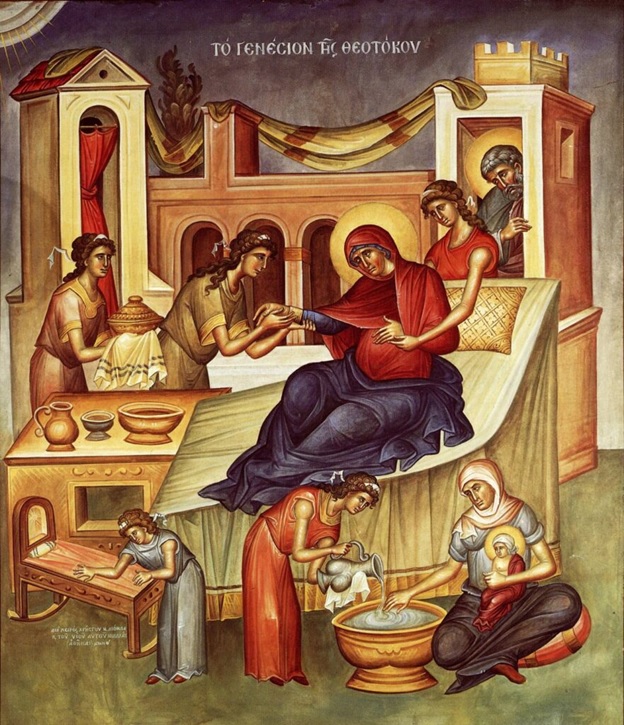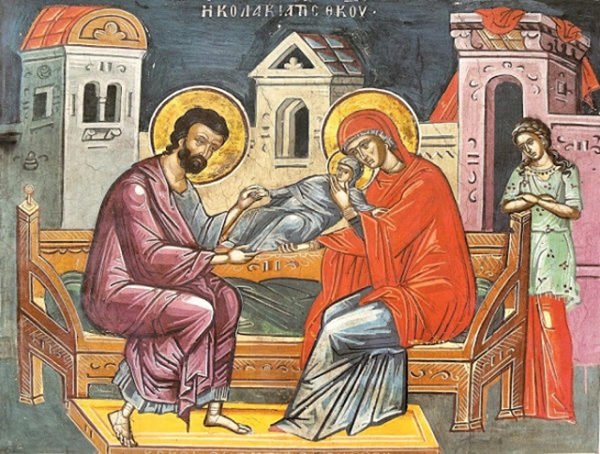‘Today is the prelude to universal joy’
12 September 2022In an earlier article of ours, we referred to the ‘Strange Features of the Dormition’ of the Mother of God, that is how an event involving sorrow, pain and suffering, as the Dormition did, is transformed by the Church into a poem of joy and, indeed, exultation. This is because the ‘death’ of our Lady is a metastasis ‘from death to life’ and, moreover, ‘from the more sorrowful to the better and more delightful and to repose and joy’ (from the Kneeling Service).
The annual liturgical cycle of the Church is completed with the life-bearing departure of our Lady and begins anew with her hope-bearing birth: ‘Today is the prelude of universal joy, today the breezes have wafted tidingσ of salvation’.
But in what does the strange feature of the birth of our most holy Lady lie? ‘In your birth, Maiden (…) you thereby diffused the painful reproach of your parents’ childlessness and the curse on childbirth of our first mother, Eve’. The event of the birth, then, is doubly miraculous. On the one hand the reproach (shame) and sorrow of her parents at their childless state are expunged and on the other the curse on child-birth incurred by our first mother Eve is loosed with the birth of the Mother of God, that is with the nativity of the Savior. And this second joy, the lifting of the curse which accompanied the whole of the human race because of the ancestral sin, is much broader and much more redemptive than the joy of her parents. It’s ‘universal joy’ because, from the new Eve, our Lady, salvation will at last dawn for the whole world.

How, then, can we not celebrate the birthday of ‘universal glory’, of the Virgin Mary? This is why the hymnographer writes: ‘Your birth, Mother of God, has brought joy to the whole of the inhabited world; for from you the sun of righteousness has risen, Christ our God. He has loosed us from the curse and given the blessing; he has abolished death and bestowed eternal life upon us’.
In the same way that, at Lauds for the feast of the Dormition, the poet presents the strange features of the miracle of the transition ‘from death to life’, so here, at Lauds for the feast of the Birth, the hymnographer again cries aloud: ‘What a strange wonder’, because, on the one hand, the ‘source of life’, the Virgin, ‘is born of the barren woman; and, on the other, the ‘God-receiving Maiden, God’s tabernacle, the most holy mountain has been given to us’.
How grateful should we be, really, that our good God gave us this blessed fruit of grace, the Maiden full of grace, ‘the divine garland’, ‘the living pavilion of his divine glory, for the joy and gladness of us all and the salvation of our souls’. Those who felt even more grateful for the ‘divine gift’ with whom the Lord rewarded and honored them for their devout and prayerful life and the good works they performed were, of course, the righteous parents of our Lady: Joachim, whose ‘gifts no longer were rejected’; and Anna, whose ‘mourning was transformed into joy’. According to the hymnographer, ‘glorious Anna’, whose very name means ‘grace of God’, proved to be ‘a living pillar of chastity and a burnished vessel shining with grace’.
Graceful Anna, then, who had formerly been barren, gave birth to the ‘precursor of grace’, the Virgin Mary, ‘preselected from all generations to accomplish the divine dispensation. Through her Christ was born and earth-dwellers were remade and renewed, [emerging] from their decay into never-ending life’.
The hymnographer, then is amazed and at a loss to understand; he has to weigh up which event to emphasize more: the joy of the forebears over the gift of a child or our own joy, that of all humankind, over the gift of salvation. And since he’s unable to decide which joy is the greater, since they’re both unheard of and immeasurable, he weaves these two joys together in his hymn: ‘today the barren gates are opened… today grace begins to bear its first-fruits’. And elsewhere: ‘from a barren root, he has made a life-giving branch spring up for us’; ‘born of a barren mother [our Lady] bore the God of all, in a manner surpassing nature’.

We, too, are at a loss as to what to admire first in these words of the hymnographer: the sublime spirit of the poet, the depth of meanings or perhaps the riches of the vocabulary and wonderful language. The God-illumined hymn-writer has achieved an excellent combination of all these.
Where he calls upon all of us to celebrate with him, however, is in the wonderful doxastiko at Vespers: ‘Come all you faithful, let us run to the Virgin…behold today the treasure of virginity is born… the holy temple, the vessel of the Godhead, the instrument of virginity, the royal chamber in which the marvelous mystery of the ineffable union of the natures coming together in Christ was accomplished’. It’s as if the hymnographer has poured into this troparion the whole of his art in order to present the truly strange mystery of the union of ‘the coming together of the natures in Christ’ in the Virgin’s womb.
All that remains for us to do, then is to respond to the general invitation and to celebrate, because ‘today is born the lifting of the curse, the recompense for the blessing, the originator of our life’ and, at the same time, entreat the Mother of God, our sweet Lady, ‘through whom the earthly is joined to the heavenly for our salvation’ to request always ‘ peace and great mercy for our souls’. Amen and many happy returns of the feast.






